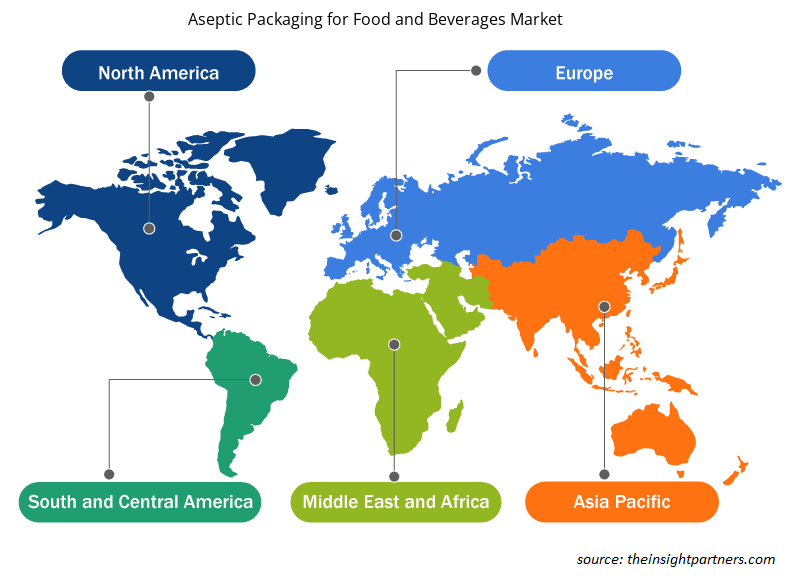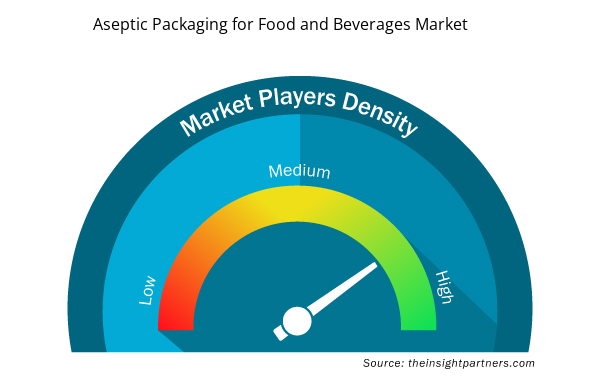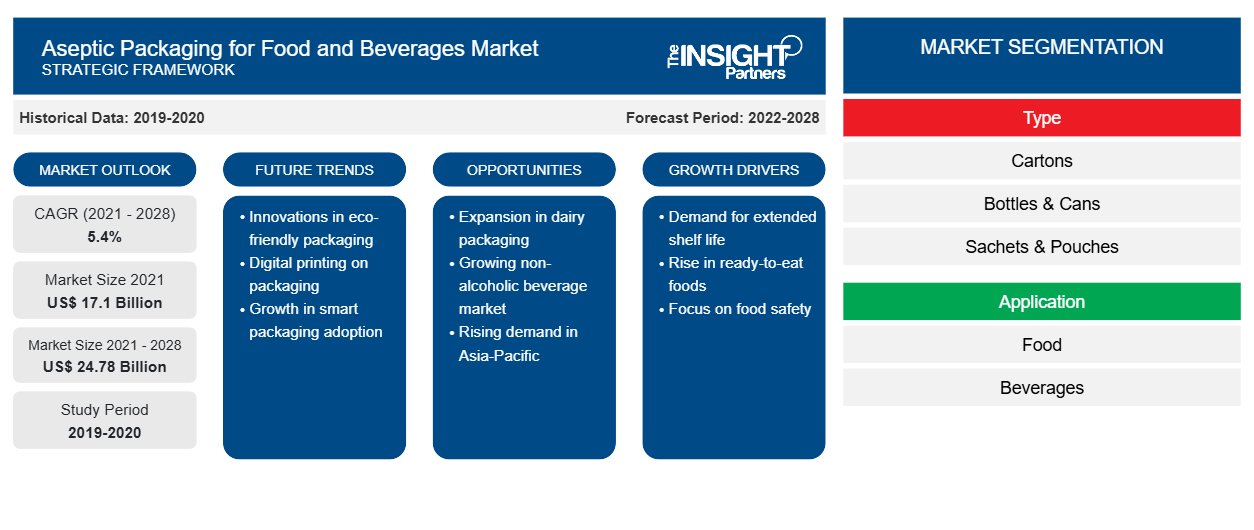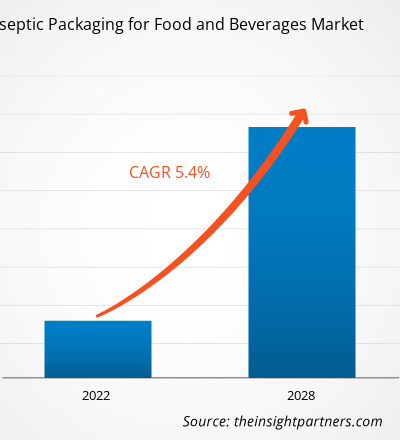食品および飲料向け無菌包装市場は、2021年の170億9,786万米ドルから2028年には247億8,233万米ドルに達すると予測されており、2021年から2028年にかけて5.4%のCAGRで成長すると予想されています。
無菌包装は、製品を商業的に滅菌し、冷却された滅菌製品を滅菌環境下で事前滅菌されたパッケージに充填するために使用される高温短時間熱処理プロセスです。プロセス中、無菌充填機は包装材料を滅菌し、滅菌環境下で滅菌製品を容器に充填し、パッケージを密閉するように設計されています。無菌充填機は、食品とパッケージが別々に滅菌される点で、従来の食品包装システムとは異なります。無菌包装は主に食品および飲料業界で使用されています。世界の食品および飲料業界の大幅な成長は、人口の増加、ライフスタイルの向上、一人当たりの所得の増加、およびコンビニエンスフードと飲料の需要の急増によるものであり、予測期間中に食品および飲料市場向けの無菌包装に重要な機会が開かれると予測されています。
北米は2020年に世界の食品および飲料向け無菌包装市場で最大のシェアを占めましたが、アジア太平洋地域は予測期間中に大幅に成長すると予想されています。北米では、すぐに食べられる、またはすぐに飲めるというコンセプトがトレンドになっています。最近、時間と労力を節約できる便利な食品や飲料が好まれるようになったため、すぐに飲める飲料市場は大幅に成長しています。食品や飲料の無菌包装は、保存期間を延ばすために不可欠です。したがって、すぐに飲める飲料の消費の高まりが、北米の食品および飲料向け無菌包装市場の成長を牽引しています。ベンダーは、すぐに飲める製品向けの特殊な無菌包装を提供しています。たとえば、Graham Packagingは、シングルサーブ包装の保存期間を延ばすために、無菌包装用のリサイクル可能なプラスチックを提供しています。このように、革新的な無菌包装ソリューションを提供する、この地域のさまざまな新興および確立された市場プレーヤーが市場の成長を牽引しています。
要件に合わせてレポートをカスタマイズする
このレポートの一部、国レベルの分析、Excelデータパックなど、あらゆるレポートを無料でカスタマイズできます。また、スタートアップや大学向けのお得なオファーや割引もご利用いただけます。
- このレポートの主要な市場動向を入手してください。この無料サンプルには、市場動向から見積もりや予測に至るまでのデータ分析が含まれます。
COVID-19パンデミックが食品・飲料市場向けアセプティック包装に与える影響
COVID-19パンデミックの間、化学品および材料業界は、原材料の供給不足、工場の閉鎖、労働力不足、およびパンデミック安全プロトコルによるその他の運用上の困難により、前例のない課題に直面しました。製造ユニットの閉鎖、原材料の調達の難しさ、および物流の制限は、食品および飲料向けの無菌包装の世界的な市場に悪影響を及ぼしました。COVID-19の発生により、消費者の衛生に対する懸念が大幅に高まりました。消費者の好みは、長い保存期間と無菌包装へと急速に進化しており、これは食品および飲料向けの無菌包装市場にプラスの影響を与えました。テトラパックインデックス2021のeコマース調査によると、消費者はますますアセプティックカートンをオンライン購入に最適な包装材料として評価しています。このように、COVID-19の発生による食品の安全性と衛生に対する懸念の高まりは、食品および飲料向けの無菌包装市場の成長を促進しています。このように、COVID-19パンデミックは、食品および飲料向けの無菌包装市場にさまざまな影響を及ぼしました。
市場洞察
アセプティック包装に関連する利点が市場の成長を牽引しています
食品および飲料製品の無菌包装には、さまざまな利点があります。無菌包装は、冷蔵せずに食品および飲料製品の保存期間を推定 6 ~ 12 か月延長するのに役立ちます。製品の寿命が長くなると、メーカーは製品の期限が切れたり風味が失われる前に製品を出荷して販売する時間が増えます。これにより、輸送および物流のコストも削減されます。無菌包装は、従来の包装タイプと比較して軽量でコンパクトなため、メーカーは出荷重量を減らすことで出荷コストを削減できます。細菌汚染がないか、細菌汚染を遅らせることができる、保存期間の長いコンビニエンス食品の需要が高まっています。食品保存料は、食品の保存期間を延ばし、製品の品質を維持するために、食品製造で広く使用されています。しかし、消費者は合成添加物を含まないより自然な製品を好みます。無菌包装は天然成分も補完するため、メーカーは完全に自然な製品を製造し、保存性を高めることができます。このように、無菌包装のさまざまな利点が、食品および飲料市場の成長を牽引しています。
タイプインサイト
タイプに基づいて、食品および飲料の無菌包装市場は、カートン、ボトルと缶、サシェとポーチ、その他に分類されます。サシェとポーチセグメントは、予測期間中に世界の食品および飲料の無菌包装市場で最も速いCAGRで成長すると予測されています。無菌ポーチ包装には、安全で便利な包装ソリューションを可能にする革新的な注ぎ口とキャップソリューションが含まれています。このポーチは、消費者に利便性と使いやすさを提供するために開発されました。最適な栄養素の保持、風味、および食感を提供しながら、最大12か月の保存期間を持つことができます。サシェは、リールまたはフラットフィルムで作られた3層または4層の包装を含む小さな密封された柔軟なバッグです。少量の食品および飲料製品の需要の高まりが、無菌サシェおよびポーチセグメントの成長を促進しています。
食品・飲料向けアセプティック包装市場の地域別分析
予測期間を通じて食品および飲料向け無菌包装市場に影響を与える地域的な傾向と要因は、Insight Partners のアナリストによって徹底的に説明されています。このセクションでは、北米、ヨーロッパ、アジア太平洋、中東、アフリカ、南米および中米にわたる食品および飲料向け無菌包装市場のセグメントと地理についても説明します。

- 食品・飲料市場向け無菌包装の地域別データを入手
食品・飲料向けアセプティック包装市場レポートの範囲
| レポート属性 | 詳細 |
|---|---|
| 2021年の市場規模 | 171億米ドル |
| 2028年までの市場規模 | 247.8億米ドル |
| 世界のCAGR(2021年~2028年) | 5.4% |
| 履歴データ | 2019-2020 |
| 予測期間 | 2022-2028 |
| 対象セグメント | タイプ別
|
| 対象地域と国 | 北米
|
| 市場リーダーと主要企業プロフィール |
|
食品および飲料向けアセプティック包装市場のプレーヤー密度:ビジネスダイナミクスへの影響を理解する
食品および飲料向け無菌包装市場は、消費者の嗜好の変化、技術の進歩、製品の利点に対する認識の高まりなどの要因により、エンドユーザーの需要が高まり、急速に成長しています。需要が高まるにつれて、企業は提供品を拡大し、消費者のニーズを満たすために革新し、新たなトレンドを活用し、市場の成長をさらに促進しています。
市場プレーヤー密度とは、特定の市場または業界内で活動している企業または会社の分布を指します。これは、特定の市場スペースに、その市場規模または総市場価値に対してどれだけの競合相手 (市場プレーヤー) が存在するかを示します。
食品および飲料向け無菌包装市場で事業を展開している主要企業は次のとおりです。
- テトラパックインターナショナルSA
- 密閉空気
- グレートビューアセプティックパッケージングカンパニー
- サイドルグループ
- エコリアンAB
免責事項:上記の企業は、特定の順序でランク付けされていません。

- 食品および飲料向け無菌包装市場のトップキープレーヤーの概要を入手
アプリケーションインサイト
用途に基づいて、食品および飲料市場向けの無菌包装は、食品と飲料に分類されます。食品セグメントはさらに、乳製品、果物と野菜、肉、鶏肉、魚介類、加工食品、その他に分類されます。飲料セグメントはさらに、乳製品飲料、ジュース、すぐに飲める飲料、その他に分類されます。飲料セグメントは、2020年に世界市場で大きなシェアを占めました。無菌包装は、フルーツベース、乳製品ベース、牛乳ベース、プロテインシェイク、すぐに飲める(RTD)紅茶とアイスコーヒー、フレーバーウォーター、カクテルなど、さまざまな飲料に使用されています。化学物質や防腐剤を含まない飲料に対する消費者の需要の高まりが、食品および飲料市場向けの無菌包装の成長を牽引しています。
食品および飲料向けアセプティック包装市場で事業を展開している主要企業には、Tetra Pak International SA、Sealed Air、Greatview Aseptic Packaging Company、Sidel Group、ECOLEAN AB、Krones AG、Syntegon Technology GmbH (Bosch Packaging Technology)、Amcor Group GmbH、IPI Srl、SIG Combibloc Group AG などがあります。これらの企業は、新たな消費者トレンドに対応する革新的な製品の開発に取り組んでいます。さらに、合併や買収、事業拡大、パートナーシップにも取り組んでおり、世界的に市場シェアを拡大しています。
レポートの注目点
- 食品および飲料市場における無菌包装の進歩的な業界動向は、プレーヤーが効果的な長期戦略を策定するのに役立ちます。
- 先進国市場と発展途上国市場で採用されているビジネス成長戦略
- 2019年から2028年までの食品および飲料市場向け無菌包装の定量分析
- 食品・飲料向け無菌包装の世界需要の推定
- 業界で活動するバイヤーとサプライヤーの有効性を示すポーターの5つの力の分析
- 競争市場の状況を理解するための最近の動向
- 食品・飲料向け無菌包装市場における市場動向と展望、成長を牽引・抑制する要因
- 商業的利益の基盤となる市場戦略を強調し、市場の成長につながる意思決定プロセスを支援する
- 食品・飲料用無菌包装市場の規模はさまざまなノードで
- 市場の詳細な概要とセグメンテーション、および食品および飲料業界の無菌包装の動向
- 有望な成長機会があるさまざまな地域の食品および飲料向け無菌包装市場の規模
- 過去2年間の分析、基準年、CAGRによる予測(7年間)
- PEST分析とSWOT分析
- 市場規模価値/数量 - 世界、地域、国
- 業界と競争環境
- Excel データセット



Report Coverage
Revenue forecast, Company Analysis, Industry landscape, Growth factors, and Trends

Segment Covered
This text is related
to segments covered.

Regional Scope
North America, Europe, Asia Pacific, Middle East & Africa, South & Central America

Country Scope
This text is related
to country scope.
よくある質問
Adoption of sustainable and environmental-friendly packaging is the key trend for the global aseptic packaging for food and beverage market. The increased use of plastic packaging in the food and beverage industry has harmful impacts on the environment. This has led to an increased focus on developing sustainable and environmental-friendly packaging.
Based on food & beverage, the food segment led the global aseptic packaging for food and beverage market in 2020. In the food segment fruits & vegetable, product is increasing as it is perishable in nature and aseptic packaging helps to increase longer shelf life. Thus this increase demand for aseptic packaging for food and beverage.
Based on the type segment, sachets & pouches was the fastest-growing segment in 2020. The aseptic sachets & pouch packaging is pre-made, sterilized spouted sachets & pouch packaging which is used to preserve the quality of the product. Aseptic sachets & pouch are shelf-stable and require no refrigeration.
In 2020, Asia Pacific accounted for the largest share of the global aseptic packaging for food and beverage market. The aseptic packaging for food and beverage market industry is anticipated to expand faster due to its benefits like longer shelf life of food and beverage.
Surging demand for dairy products and benefits associated with aseptic packaging are the drivers for global aseptic packaging for food and beverage market. The growing demand for dairy products has led to an increased focus on developing safe and hygienic packaging for dairy products. Aseptic packaging is increasingly used as a packaging solution for ultra-high temperature (UHT) milk. Aseptic packaging helps increase the shelf life of the food and beverage products.
The major players operating in the global aseptic packaging for food and beverage market are Tetra Pak International S.A.; Sealed Air Corporation; Greatview Aseptic Packaging Co., Ltd.; Sidel International; Ecolean AB; Krones AG; Syntegon Technology GmbH; IPI S.r.l.; SIG Combibloc Group AG; Amcor plc.
Trends and growth analysis reports related to Chemicals and Materials : READ MORE..
The List of Companies - Aseptic Packaging for Food and Beverage Market
- Tetra Pak International S.A
- Sealed Air
- Greatview Aseptic Packaging Company
- SIDEL GROUP
- ECOLEAN AB
- Krones AG
- Syntegon Technology GmbH (Bosch Packaging Technology)
- SIG Combibloc Group AG
- IPI S.R.L.
- Amcor plc
The Insight Partners performs research in 4 major stages: Data Collection & Secondary Research, Primary Research, Data Analysis and Data Triangulation & Final Review.
- Data Collection and Secondary Research:
As a market research and consulting firm operating from a decade, we have published and advised several client across the globe. First step for any study will start with an assessment of currently available data and insights from existing reports. Further, historical and current market information is collected from Investor Presentations, Annual Reports, SEC Filings, etc., and other information related to company’s performance and market positioning are gathered from Paid Databases (Factiva, Hoovers, and Reuters) and various other publications available in public domain.
Several associations trade associates, technical forums, institutes, societies and organization are accessed to gain technical as well as market related insights through their publications such as research papers, blogs and press releases related to the studies are referred to get cues about the market. Further, white papers, journals, magazines, and other news articles published in last 3 years are scrutinized and analyzed to understand the current market trends.
- Primary Research:
The primarily interview analysis comprise of data obtained from industry participants interview and answers to survey questions gathered by in-house primary team.
For primary research, interviews are conducted with industry experts/CEOs/Marketing Managers/VPs/Subject Matter Experts from both demand and supply side to get a 360-degree view of the market. The primary team conducts several interviews based on the complexity of the markets to understand the various market trends and dynamics which makes research more credible and precise.
A typical research interview fulfils the following functions:
- Provides first-hand information on the market size, market trends, growth trends, competitive landscape, and outlook
- Validates and strengthens in-house secondary research findings
- Develops the analysis team’s expertise and market understanding
Primary research involves email interactions and telephone interviews for each market, category, segment, and sub-segment across geographies. The participants who typically take part in such a process include, but are not limited to:
- Industry participants: VPs, business development managers, market intelligence managers and national sales managers
- Outside experts: Valuation experts, research analysts and key opinion leaders specializing in the electronics and semiconductor industry.
Below is the breakup of our primary respondents by company, designation, and region:

Once we receive the confirmation from primary research sources or primary respondents, we finalize the base year market estimation and forecast the data as per the macroeconomic and microeconomic factors assessed during data collection.
- Data Analysis:
Once data is validated through both secondary as well as primary respondents, we finalize the market estimations by hypothesis formulation and factor analysis at regional and country level.
- Macro-Economic Factor Analysis:
We analyse macroeconomic indicators such the gross domestic product (GDP), increase in the demand for goods and services across industries, technological advancement, regional economic growth, governmental policies, the influence of COVID-19, PEST analysis, and other aspects. This analysis aids in setting benchmarks for various nations/regions and approximating market splits. Additionally, the general trend of the aforementioned components aid in determining the market's development possibilities.
- Country Level Data:
Various factors that are especially aligned to the country are taken into account to determine the market size for a certain area and country, including the presence of vendors, such as headquarters and offices, the country's GDP, demand patterns, and industry growth. To comprehend the market dynamics for the nation, a number of growth variables, inhibitors, application areas, and current market trends are researched. The aforementioned elements aid in determining the country's overall market's growth potential.
- Company Profile:
The “Table of Contents” is formulated by listing and analyzing more than 25 - 30 companies operating in the market ecosystem across geographies. However, we profile only 10 companies as a standard practice in our syndicate reports. These 10 companies comprise leading, emerging, and regional players. Nonetheless, our analysis is not restricted to the 10 listed companies, we also analyze other companies present in the market to develop a holistic view and understand the prevailing trends. The “Company Profiles” section in the report covers key facts, business description, products & services, financial information, SWOT analysis, and key developments. The financial information presented is extracted from the annual reports and official documents of the publicly listed companies. Upon collecting the information for the sections of respective companies, we verify them via various primary sources and then compile the data in respective company profiles. The company level information helps us in deriving the base number as well as in forecasting the market size.
- Developing Base Number:
Aggregation of sales statistics (2020-2022) and macro-economic factor, and other secondary and primary research insights are utilized to arrive at base number and related market shares for 2022. The data gaps are identified in this step and relevant market data is analyzed, collected from paid primary interviews or databases. On finalizing the base year market size, forecasts are developed on the basis of macro-economic, industry and market growth factors and company level analysis.
- Data Triangulation and Final Review:
The market findings and base year market size calculations are validated from supply as well as demand side. Demand side validations are based on macro-economic factor analysis and benchmarks for respective regions and countries. In case of supply side validations, revenues of major companies are estimated (in case not available) based on industry benchmark, approximate number of employees, product portfolio, and primary interviews revenues are gathered. Further revenue from target product/service segment is assessed to avoid overshooting of market statistics. In case of heavy deviations between supply and demand side values, all thes steps are repeated to achieve synchronization.
We follow an iterative model, wherein we share our research findings with Subject Matter Experts (SME’s) and Key Opinion Leaders (KOLs) until consensus view of the market is not formulated – this model negates any drastic deviation in the opinions of experts. Only validated and universally acceptable research findings are quoted in our reports.
We have important check points that we use to validate our research findings – which we call – data triangulation, where we validate the information, we generate from secondary sources with primary interviews and then we re-validate with our internal data bases and Subject matter experts. This comprehensive model enables us to deliver high quality, reliable data in shortest possible time.


 このレポートの無料サンプルを入手する
このレポートの無料サンプルを入手する